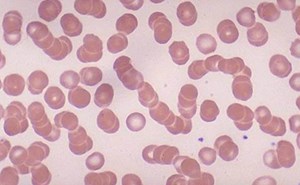
The Role of Thromboelastometry in Monitoring Critical Patients
Introduction

Over the last several years, resuscitation practices in hemorrhaging patients have changed dramatically in both the ED and the ICU environments. The focus on principles of damage control resuscitation has led to increased use of blood products for transfusion in trauma and reduced emphasis on crystalloid boluses. Increasingly, a goal of balanced transfusion of either whole blood, or a ratio-based mix of blood components, is used in massive resuscitation from trauma.1 Likewise, recognition of the deleterious effects of trauma induced coagulopathy, a state of dysregulated coagulation associated with higher injury severity scores (ISS), has underscored the importance of the diagnosis and treatment of clotting abnormalities in bleeding patients.2,3
In addition to conventional clotting assays (CCAs), such as PT/INR, PTT, and platelet and fibrinogen counts, viscoelastic testing technology can be used to tailor resuscitation and diagnose coagulopathy, with the potential for faster and more comprehensive assessments of clotting. This technology relies on the principle of thromboelastometry, in which the strength of a clot is measured over time in relation to a torsional strain. The tests currently available to perform thromboelastometry include thromboelastography, TEG® (Haemonetics Corporation, Braintree MA), and rotational thromboelastometry, ROTEM® (Instrumentation Laboratory, Bedford MA). This review will discuss the basic mechanisms of these technologies, summarize the data on viscoelastic testing use in various clinical settings, and examine the potential benefits of viscoelastic testing use in the ED and ICU.
Viscoelastic Testing Modalities
Mechanistically, TEG and ROTEM both rely on measurements of the torsional force exerted on a pin suspended within a disposable plastic cup containing a sample of a patient’s whole blood. While TEG operates by spinning the cup itself, ROTEM devices spin the pin while holding the cup stable.4 The devices generate a graph of the measured elasticity of the blood, expressed in millimeters (mm), over time as a clot forms. Both tests yield numerical results describing time to clot development (in minutes), clot formation kinetics, maximum clot strength, and degree of fibrinolysis present, although nomenclature varies between the two devices. As point-of-care testing devices, they are designed for use by providers at the bedside. The first results typically become available in a few minutes from these tests, although more than 30 minutes is required for determination of all available parameters.
Interpretation of results requires knowledge of which chemical activators were used in the test. For TEG, kaolin is used, sometimes in combination with tissue factor (TF) for a “rapid TEG” or “rTEG” test. These reagents are similar to those used for testing of the PTT and PT in plasma samples, respectively. ROTEM, by contrast, allows for multiple parallel testing channels tailored towards specific aspects of clotting, whether the extrinsic pathway (EXTEM), intrinsic pathway (INTEM), fibrinogen contribution (FIBTEM), or others, each of which requires different activators specified by the manufacturer. For this reason, certain test results from ROTEM, in particular, show expected high correlation with CCA results and fibrinogen counts.5,6 However, neither device is designed to replicate conventional laboratory results, but rather both work as novel comprehensive means to investigate clotting disorders.
Clinical Applications of TEG and ROTEM in the ED and ICU
Clinical strengths of TEG and ROTEM for use in the ED and ICU include the availability of rapid test results and performance at the bedside, both of which may improve care compared to conventional testing and treatment strategies. Using the example of trauma care within the ED, multiple protocols incorporating viscoelastic testing into component transfusion therapy for trauma have been published, showing improved results in retrospective, non-randomized comparisons.7,8 A prospective cohort study found that rTEG results were available within 5-15 minutes and predicted transfusion requirements, and that CCA results were not available until 48 minutes.9 A similar study of wait times found rTEG available after 30 minutes, compared to 64 minutes for CCA, when measuring from patient arrival.10 Whole blood assessment of coagulation, used in viscoelastic methods but not in CCAs, has also been proposed as a more valid physiologic measure of the interaction between plasma clotting proteins with red blood cells and platelets.11 In trauma, both TEG and ROTEM have similar clinical performance for prediction of mortality and transfusion requirements.12
The ability to detect hyperfibrinolysis represents a unique contribution of viscoelastic methods to coagulation testing. Fibrinolysis is defined as the percentage of clot strength reduction from the maximal level at a time point following test initiation, typically 30 minutes. In a cohort of 73 traumatically injured patients, increased percent clot lysis at 30 minutes (%LY30) beyond 3% was associated with significant increases in transfusion requirements and overall mortality.13 Further, a cohort study of 2,540 patients after major trauma noted that a phenotype of fibrinolytic shutdown (<0.8% lysis) was present in 46% of patients and associated with intermediate mortality above those with physiologic fibrinolysis levels, but below patients with hyperfibrinolytic state.14 A U-shaped mortality and prevalence distribution based on fibrinolysis measurements after major trauma appears to be present based on similar studies.15 Although administration of antifibrinolytic medications, such as tranexamic acid (TXA), was predicted to mitigate the mortality risk of hyperfibrinolysis, a study of 232 patients utilizing a protocol of TEG-guided TXA administration did not find benefit.16
Outcomes on TEG and ROTEM Use in Other Clinical Settings
TEG and ROTEM based transfusion strategies have already demonstrated improved outcomes in multiple situations where hemorrhagic complications are encountered, most notably cardiac surgery, liver transplantation, and obstetrics.17 In cardiac surgery, use of point-of-care viscoelastic testing is associated with reduced rates of transfusion and reduced need for surgical re-exploration.18 In a group of 68 patients undergoing liver transplant, use of a ROTEM-guided transfusion protocol reduced intraoperative blood loss and direct costs of hospitalization, with increased rates of cryoprecipitate and reduced rates of FFP transfusion.19 In obstetrics, ROTEM has been used in treatment of postpartum hemorrhage to diagnose the changes in fibrinogen concentrations encountered more frequently in women with hemorrhagic complications.20 Using a ROTEM-based protocol incorporating FIBTEM and EXTEM channels, a retrospective cohort study of 86 patients with postpartum hemorrhage demonstrated reduced rates of transfusion, hysterectomy, and lower hospitalization length of stay and costs in comparison to a standardized massive transfusion protocol.21
Limitations
Currently, limitations of this technology include difficulties with interpretation of results, incomplete detection of certain anticoagulant agents, and modest availability of testing devices within ED and ICU settings. Viscoelastic testing is not sufficiently sensitive, without modifications, to antiplatelet agents including aspirin and clopidogrel.22 Although both ROTEM and TEG may show abnormal clotting profiles in the presence of direct oral anticoagulants (DOACs), these tests have not proven sufficiently accurate to be recommended as detection or monitoring devices for patients on DOACs.23,24 No estimates for provider knowledge about the use of viscoelastic testing in the EM community exists, but anecdotally this appears to be low, with use of these devices being infrequent outside of a few major clinical centers. Given the long track record of CCAs for monitoring coagulopathy, along with a more intuitive relationship of CCA abnormalities to individual blood component requirements, adoption of viscoelastic testing technology has been slow. As research in this field continues, and studies show improved care outcomes and reduced costs with ROTEM or TEG use, familiarity and availability are likely to improve within the EM/CCM community.
References
- Holcomb JB, Tilley BC, Baraniuk S, et al. Transfusion of plasma, platelets, and red blood cells in a 1:1:1 vs a 1:1:2 ratio and mortality in patients with severe trauma: the PROPPR randomized clinical trial. JAMA. 2015;313(5):471-82.
- Brohi K, Singh J, Heron M, et al. Acute traumatic coagulopathy. J Trauma. 2003;54(6):1127-1130.
- Hunt H, Stanworth S, Curry N, et al. Thromboelastography (TEG) and rotational thromboelastometry (ROTEM) for trauma induced coagulopathy in adult trauma patients with bleeding. Cochrane Database Syst Rev. 2015 Feb 16;(2):CD010438.
- Tynngård N, Lindahl TL, Ramström S. Assays of different aspects of haemostasis – what do they measure? Thromb J. 2015 Feb 5;13(1):8.
- Haas T, Spielmann N, Mauch J, et al. Comparison of thromboelastometry (ROTEM®) with standard plasmatic coagulation testing in paediatric surgery. Br J Anaesth. 2012 Jan;108(1):36-41.
- Rugeri L, Levrat A, David JS, et al. Diagnosis of early coagulation abnormalities in trauma patients by rotation thrombelastography. J Thromb Haemost. 2007 Feb;5(2):289-95.
- Holcomb JB, Minei KM, Scerbo ML, et al. Admission rapid thrombelastography can replace conventional coagulation tests in the emergency department: experience with 1974 consecutive trauma patients. Ann Surg. 2012 Sep;256(3):476-86.
- Tapia NM, Chang A, Norman M, et al. TEG-guided resuscitation is superior to standardized MTP resuscitation in massively transfused penetrating trauma patients. J Trauma Acute Care Surg. 2013 Feb;74(2):378-85; discussion 385-6.
- Cotton BA, Faz G, Hatch QM, et al. Rapid thrombelastography delivers real-time results that predict transfusion within 1 hour of admission. J Trauma. 2011 Aug;71(2):407-14; discussion 414-7.
- Jeger V, Zimmermann H, Exadaktylos AK. Can RapidTEG accelerate the search for coagulopathies in the patient with multiple injuries? J Trauma. 2009 Apr;66(4):1253-7.
- Ganter MT, Hofer CK. Coagulation monitoring: current techniques and clinical use of viscoelastic point-of-care coagulation devices. Anesth Analg. 2008 May;106(5):1366-75.
- Rizoli S, Min A, Sanchez AP, et al. In trauma, conventional ROTEM and TEG results are not interchangeable but are similar in clinical applicability. Mil Med. 2016 May;181(5 Suppl):117-26.
- Chapman MP, Moore EE, Ramos CR, et al. Fibrinolysis greater than 3% is the critical value for initiation of antifibrinolytic therapy. J Trauma Acute Care Surg. 2013;75(6):961-967; discussion 967.
- Moore HB, Moore EE, Liras IN, et al. Acute fibrinolysis shutdown after injury occurs frequently and increases mortality: a multicenter evaluation of 2,540 severely injured patients. J Am Coll Surg. 2016 Apr;222(4):347-55.
- Moore HB, Moore EE, Gonzalez E, et al. Hyperfibrinolysis, physiologic fibrinolysis, and fibrinolysis shutdown: the spectrum of postinjury fibrinolysis and relevance to antifibrinolytic therapy. J Trauma Acute Care Surg. 2014 Dec;77(6):811-7; discussion 817.
- Moore HB, Moore EE, Huebner BR, et al. Tranexamic acid is associated with increased mortality in patients with physiological fibrinolysis. J Surg Res. 2017 Dec;220:438-43.
- Wikkelsø A, Wetterslev J, Møller AM, et al. Thromboelastography (TEG) or thromboelastometry (ROTEM) to monitor haemostatic treatment versus usual care in adults or children with bleeding. Cochrane Database Syst Rev. 2016 Aug 22;(8):CD007871.
- Deppe A-C, Weber C, Zimmermann J, et al. Point-of-care thromboelastography/ thromboelastometry-based coagulation management in cardiac surgery: a meta-analysis of 8332 patients. J Surg Res. 2016 Jun 15;203(2):424-33.
- Smart L, Mumtaz K, Scharpf D, et al. Rotational thromboelastometry or conventional coagulation tests in liver transplantation: comparing blood loss, transfusions, and cost. Ann Hepatol. 2017 Nov-Dec;16(6):916-23.
- Kaufner L, Henkelmann A, von Heymann C, et al. Can prepartum thromboelastometry-derived parameters and fibrinogen levels really predict postpartum hemorrhage? J Perinat Med. 2017 May 24;45(4):427-35.
- Snegovskikh D, Souza D, Walton Z, et al. Point-of-care viscoelastic testing improves the outcome of pregnancies complicated by severe postpartum hemorrhage. J Clin Anesth. 2018 Feb;44:50-6.
- Trentalange MJ, Walts LF. A comparison of thromboelastogram and template bleeding time in the evaluation of platelet function after aspirin ingestion. J Clin Anesth. 1991 Sep-Oct;3(5):377-81.
- Mahamad S, Chaudhry H, Nisenbaum R, et al. Exploring the effect of factor Xa inhibitors on rotational thromboelastometry: a case series of bleeding patients. J Thromb Thrombolysis. 2019 Feb;47(2):272-9.
- Dias JD, Norem K, Doorneweerd DD, et al. Use of thromboelastography (TEG) for detection of new oral anticoagulants. Arch Pathol Lab Med. 2015 May;139(5):665-73.
Patrick Maher, MD



